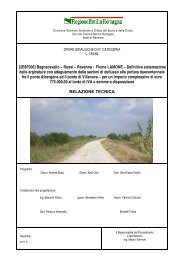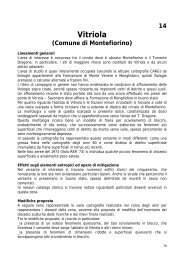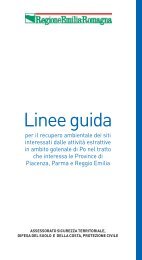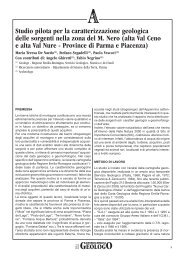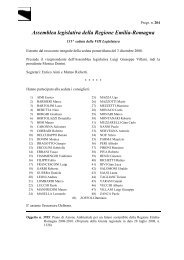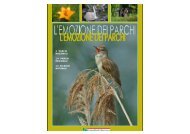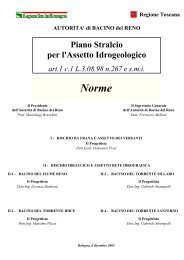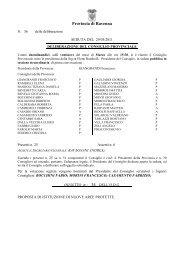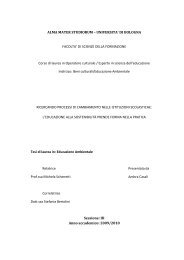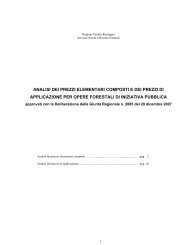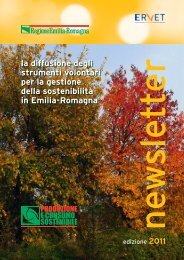air, water and soil quality qualité - ER Ambiente - Regione Emilia ...
air, water and soil quality qualité - ER Ambiente - Regione Emilia ...
air, water and soil quality qualité - ER Ambiente - Regione Emilia ...
Create successful ePaper yourself
Turn your PDF publications into a flip-book with our unique Google optimized e-Paper software.
è necessaria (per esempio, le condizioni dell’assorbimento, influenza ambientale, i<br />
parametri specifici dei suoli, il comportamento dei microbi del suolo) per la valutazione<br />
migliore del rischio per l’inquinamento dell’ambiente.<br />
Basato su questa comprensione, la valutazione dell’assorbimento, proporzione<br />
della degradazione ed i rischi conseguenti dell’inquinamento delle acque superficiale<br />
e falde è possibile.<br />
Parole chiave: inquinanti organici; rischio dell’inquinamento ambientale; glyphosate;<br />
run-off superficiale; assorbimento; proprietá del suolo; processi nel suolo.<br />
Introduction<br />
Organic pollutants are mainly man-made <strong>and</strong> industrially produced. Nowadays<br />
they are present in <strong>water</strong> systems, run-off, <strong>soil</strong> <strong>and</strong> food (Ternan et al., 1998). Soils<br />
play an important role in the regulation of contaminants in ecosystems. There is a<br />
growing concern about identifying <strong>and</strong> underst<strong>and</strong>ing the mechanisms controlling<br />
the fate of chemicals which are threat for non-target organisms <strong>and</strong> a source of<br />
environmental contamination, especially of <strong>water</strong> sources. Since the organic pollutants<br />
are released in environment often in enormous quantities <strong>and</strong> among the<br />
herbicides the most applied is glyphosate, there is a considerable risk of these pollutants.<br />
A better underst<strong>and</strong>ing of organic behavior in <strong>soil</strong>s is important for the<br />
improvement of environmental protection. There is a need for more specified pesticide<br />
management based on the adaptation of the pesticide type <strong>and</strong> application<br />
rates to the characteristics of the area of application (Eriksson et al., 2007; Crommentuijn<br />
et al., 2000; Zablotowicz et al., 2006; Lupwayi et al., 2007; Peruzzo et<br />
al., 2008; Renaud et al., 2004; Warnemuende et al., 2007; Albrechsten et al., 2001;<br />
Papiernik SK, 2001).<br />
The behaviour of organic contaminants in <strong>soil</strong>s is generally governed by a variety<br />
of physical, chemical <strong>and</strong> biological processes, including sorption–desorption,<br />
volatilization, chemical <strong>and</strong> biological degradation, uptake by plants, run-off, <strong>and</strong><br />
leaching (Fig.1) (Mamy et al., 2005).<br />
Special focus of this presentation is given on glyphosate <strong>and</strong> AMPA. Glyphosate is<br />
an organophosphonate herbicide, nowadays one of the most applied in the world<br />
with increasing importance.<br />
Glyphosate fate <strong>and</strong> behavior in <strong>soil</strong> is affected by different <strong>soil</strong> factors <strong>and</strong> processes,<br />
but depends also on interaction between herbicide <strong>and</strong> <strong>soil</strong> under the specific<br />
local conditions (Locke & Zablotowicz, 2004; Soulas & Lagacherie, 2001; Gimsing<br />
et al., 2004).<br />
Knowledge of glyphosates behavior depends on our underst<strong>and</strong>ing of herbicide<br />
characteristics, environmental influence, specific <strong>soil</strong> parameters <strong>and</strong> <strong>soil</strong> microbes<br />
behavior. Based on this knowledge, time dependent adsorption/degradation rates<br />
<strong>and</strong> consequently risks for environmental pollution involved can be estimated <strong>and</strong><br />
better attenuated.<br />
102



